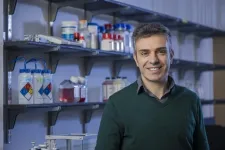(Press-News.org) Households with gas or propane stoves regularly breathe unhealthy levels of nitrogen dioxide, a study of air pollution in U.S. homes found.
“I didn’t expect to see pollutant concentrations breach health benchmarks in bedrooms within an hour of gas stove use, and stay there for hours after the stove is turned off,” said Stanford Doerr School of Sustainability Professor Rob Jackson, senior author of the May 3 study in Science Advances. Pollution from gas and propane stoves isn’t just an issue for cooks or people in the kitchen, he said. “It’s the whole family’s problem.”
Among other negative health effects, breathing high levels of nitrogen dioxide, or NO2, over time can intensify asthma attacks and has been linked to decreased lung development in children and early deaths.
Although most exposure to NO2 is caused by cars and trucks burning fossil fuels, the researchers estimate that the mix of pollutants coming from gas and propane stoves overall may be responsible for as many as 200,000 current childhood asthma cases. One quarter of these can be attributed to nitrogen dioxide alone, according to the paper’s authors, who include scientists from Central California Asthma Collaborative, PSE Healthy Energy, and the Harvard T.H. Chan School of Public Health.
“We found that just how much gas you burn in your stove is by far the biggest factor affecting how much you’re exposed. And then, after that, do you have an effective range hood – and do you use it?” said lead study author Yannai Kashtan, a PhD student in Earth system science.
Little room for additional exposure
Beyond asthma cases, the long-term exposure to NO2 in American households with gas stoves is high enough to cause thousands of deaths each year – possibly as many as 19,000 or 40% of the number of deaths linked annually to secondhand smoke. This estimate is based on the researchers’ new measurements and calculations of how much nitrogen dioxide people breathe at home because of gas stoves and the best available data on deaths from long-term exposure to outdoor NO2, which is regulated by the U.S. Environmental Protection Agency.
The death toll estimate is approximate in part because it does not factor in the harmful effects of repeated exposure to extremely high levels of nitrogen dioxide in short bursts, as occurs in homes with gas stoves. It also relies on past studies of health impacts from nitrogen dioxide encountered outdoors, where additional pollutants from vehicles and power plants are present.
The researchers used sensors to measure concentrations of NO2 throughout more than 100 homes of various sizes, layouts, and ventilation methods, before, during, and after stove use. They incorporated these measurements and other data into a model powered by National Institutes for Standards and Technology (NIST) software known as CONTAM for simulating airflow, contaminant transport, and room-by-room occupant exposure in buildings. This allowed them to estimate nationwide averages and short-term exposures under a range of realistic conditions and behaviors, and cross-check model outputs against their home measurements.
The results show that nationwide, typical use of a gas or propane stove increases exposure to nitrogen dioxide by an estimated 4 parts per billion, averaged over a year. That’s three quarters of the way to the nitrogen dioxide exposure level that the World Health Organization recognizes as unsafe in outdoor air. “That’s excluding all outdoor sources combined, so it makes it much more likely you’re going to exceed the limit,” said Kashtan.
Understanding how gas stoves affect health
The study is the latest in a series from Jackson’s group at Stanford looking at indoor air pollution from gas stoves. Earlier studies documented the rate at which gas stoves emit other pollutants, including the greenhouse gas methane and the carcinogen benzene. But to understand the implications of stove emissions for human health, the researchers needed to find out how much pollutants spread through a home, build up, and eventually dissipate. “We’re moving from measuring how much pollution comes from stoves to how much pollution people actually breathe,” said Jackson, who is the Michelle and Kevin Douglas Provostial Professor in Earth System Science.
With any fuel source, particle pollution can rise from food cooking in a hot pan. The new research confirms that food emits little or no nitrogen dioxide as it cooks, however, and electric stoves produce no NO2. “It’s the fuel, not the food,” said Jackson. “Electric stoves emit no nitrogen dioxide or benzene. If you own a gas or propane stove, you need to reduce pollutant exposures using ventilation.”
Home size matters
Even in larger homes, concentrations of nitrogen dioxide routinely spiked to unhealthy levels during and after cooking even if a range hood was on and venting air outdoors. But people who live in homes smaller than 800 square feet – about the size of a small two-bedroom apartment – are exposed to twice as much nitrogen dioxide over the course of a year compared to the national average, and four times more compared to those living in the largest homes, upwards of 3,000 square feet.
Because home size makes such a difference, there are also differences in exposure across racial, ethnic, and income groups. Compared to the national average, the researchers found long-term NO2 exposure is 60% higher among American Indian and Alaska Native households, and 20% higher among Black and Hispanic or Latino households. This exposure to indoor air pollution from gas stoves compounds the fact that exposure to outdoor sources of nitrogen dioxide pollution, such as vehicle exhaust, is also typically higher among people in poorer, often minority, communities.
“People in poorer communities can’t always afford to change their appliances, or perhaps they rent and can’t replace appliances because they don’t own them,” Jackson said. “People in smaller homes are also breathing more pollution for the same stove use.”
Jackson is also a senior fellow at the Stanford Woods Institute for the Environment and Precourt Institute for Energy. Additional Stanford co-authors include Metta Nicholson, a PhD student in the Emmett Interdisciplinary Program in Environment and Resources (E-IPER); Colin Finnegan, a laboratory manager in the Department of Earth System Science; and Earth system science postdoctoral scholars Zutao Ouyang and Anchal Garg.
This research was supported by HT, LLC.
END
Quantifying U.S. health impacts from gas stoves
People with gas and propane stoves breathe more unhealthy nitrogen dioxide
2024-05-03
ELSE PRESS RELEASES FROM THIS DATE:
Physics confirms that the enemy of your enemy is, indeed, your friend
2024-05-03
Most people have heard the famous phrase “the enemy of my enemy is my friend.”
Now, Northwestern University researchers have used statistical physics to confirm the theory that underlies this famous axiom.
The study will be published on May 3 in the journal Science Advances.
In the 1940s, Austrian psychologist Fritz Heider introduced social balance theory, which explains how humans innately strive to find harmony in their social circles. According to the theory, four rules — an enemy of an enemy is a friend, a friend of a ...
Stony coral tissue loss disease is shifting the ecological balance of Caribbean reefs
2024-05-03
The outbreak of a deadly disease called stony coral tissue loss disease is destroying susceptible species of coral in the Caribbean while helping other, “weedier” organisms thrive — at least for now — according to a new study published today in Science Advances.
Researchers say the drastic change in the region’s population of corals is sure to disrupt the delicate balance of the ecosystem and threaten marine biodiversity and coastal economies.
“Some fast-growing organisms, like algae, ...
Newly discovered mechanism of T-cell control can interfere with cancer immunotherapies
2024-05-03
Activated T cells that carry a certain marker protein on their surface are controlled by natural killer (NK) cells, another cell type of the immune system. In this way, the body presumably curbs destructive immune reactions. Researchers from the German Cancer Research Center (DKFZ) and the University Medical Center Mannheim (UMM) now discovered that NK cells can impair the effect of cancer therapies with immune checkpoint inhibitors (ICI) in this way. They could also be responsible for the rapid decline of therapeutic CAR-T cells. Interventions in this mechanism could ...
Wistar scientists discover new immunosuppressive mechanism in brain cancer
2024-05-03
PHILADELPHIA — (May 3, 2024) — The Wistar Institute assistant professor Filippo Veglia, Ph.D., and team, have discovered a key mechanism of how glioblastoma — a serious and often fatal brain cancer — suppresses the immune system so that the tumor can grow unimpeded by the body’s defenses. The lab’s discovery was published in the paper, “Glucose-driven histone lactylation promotes the immunosuppressive activity of monocyte-derived macrophages in glioblastoma,” in the journal Immunity.
“Our study shows that the cellular mechanisms of cancer’s self-preservation, when sufficiently understood, can be used against the disease very effectively,” ...
ADA Forsyth ranks number 1 on the East Coast in oral health research
2024-05-03
Cambridge, Mass., – ADA Forsyth Institute (AFI) researchers received just under $10 million funding from the National Institute of Dental and Craniofacial Research (NIDCR) during the federal fiscal year 2023, placing 4th nationally on NIDCR’s ranking list.
“We have ranked in the top 5 dental institutions in 9 out of the past 10 years,” said Wenyuan Shi, PhD, Chief Executive Officer of AFI. “We have placed in the top 10 nationally every year since the ranking system began in 2002, despite having one of the smallest faculty ...
The American Ornithological Society (AOS) names Judit Szabo as new Ornithological Applications editor-in-chief
2024-05-03
May 3, 2024—CHICAGO—The American Ornithological Society (AOS) is pleased to announce Judit K. Szabo, Ph.D., as the incoming editor-in-chief for its top-ranked journal, Ornithological Applications. Beginning on May 1, 2024, Szabo will work in partnership with the journal’s current editor-in-chief, Catherine Lindell, Ph.D., until June 30, 2024, and will take on full responsibility as editor-in-chief beginning on July 1, 2024. “With her international interest and network, conservation experience, and thoughtful approach ...
Catheter-directed mechanical thrombectomy system demonstrates safety and effectiveness in patients with pulmonary embolism
2024-05-03
Long Beach, Calif. – May 3, 2024 – New data from the Acute Pulmonary Embolism Extraction Trial with the AlphaVac System (APEX-AX) demonstrated that catheter-directed mechanical thrombectomy is safe and effective in patients with acute intermediate-risk pulmonary embolism (PE) with significant improvement in the right ventricle (RV) function and minimal major adverse events. The safety and efficacy results from the prospective trial were presented today as late-breaking science at the Society for Cardiovascular Angiography & Interventions (SCAI) 2024 Scientific Sessions.
Pulmonary embolism (PE), a blood clot that blocks and stops ...
Novel thrombectomy system demonstrates positive safety and feasibility results in treating acute pulmonary embolism
2024-05-03
Long Beach, Calif. – May 3, 2024 – Late-breaking data from the ENGULF trial showed that a novel dual-action thrombectomy device was effective and safe in treating acute pulmonary embolism (PE). The safety and effectiveness results were presented today as late-breaking science at the Society for Cardiovascular Angiography & Interventions (SCAI) 2024 Scientific Sessions and simultaneously published in JSCAI.
PE is a serious cardiovascular event where a blood clot causes issues with blood flow and oxygen levels in the lungs. It can be ...
Biomimetic transcatheter aortic heart valve offers new option for aortic stenosis patients
2024-05-03
Long Beach, Calif. – May 3, 2024 – Recent findings from a study on a transcatheter heart valve (THV) system, which includes a new class of transcatheter aortic valve, showed positive results in the device's ability to function as a healthy and natural aortic valve in patients with aortic stenosis (AS). The late-breaking data will be presented today at the Society for Cardiovascular Angiography & Interventions (SCAI) 2024 Scientific Sessions.
AS is a thickening and narrowing of the aortic valve that can reduce blood flow to ...
SMART trial reaffirms hemodynamic superiority of TAVR self-expanding valve in aortic stenosis patients with a small annulus over time and regardless of age
2024-05-03
Long Beach, Calif. – May 3, 2024 – Additional analysis from the SMall Annuli Randomized To Evolut or SAPIEN (SMART) study demonstrated clinical non-inferiority of self-expanding valves (SEV) versus balloon-expandable valves (BEV) in aortic stenosis patients undergoing transcatheter aortic valve replacement (TAVR) and confirmed valve performance superiority over time based on hemodynamics. Data also showed similar positive results in two age groups (< or ≥ 80 years old). The late-breaking results were presented today at the Society for Cardiovascular Angiography & Interventions ...
LAST 30 PRESS RELEASES:
Sleeping in on weekends may help boost teens’ mental health
Study: Teens use cellphones for an hour a day at school
After more than two years of war, Palestinian children are hungry, denied education and “like the living dead”
The untold story of life with Prader-Willi syndrome - according to the siblings who live it
How the parasite that ‘gave up sex’ found more hosts – and why its victory won’t last
When is it time to jump? The boiling frog problem of AI use in physics education
Twitter data reveals partisan divide in understanding why pollen season's getting worse
AI is quick but risky for updating old software
Revolutionizing biosecurity: new multi-omics framework to transform invasive species management
From ancient herb to modern medicine: new review unveils the multi-targeted healing potential of Borago officinalis
Building a global scientific community: Biological Diversity Journal announces dual recruitment of Editorial Board and Youth Editorial Board members
Microbes that break down antibiotics help protect ecosystems under drug pollution
Smart biochar that remembers pollutants offers a new way to clean water and recycle biomass
Rice genes matter more than domestication in shaping plant microbiomes
Ticking time bomb: Some farmers report as many as 70 tick encounters over a 6-month period
Turning garden and crop waste into plastics
Scientists discover ‘platypus galaxies’ in the early universe
Seeing thyroid cancer in a new light: when AI meets label-free imaging in the operating room
Neutrophil-to-lymphocyte ratio may aid risk stratification in depressive disorder
2026 Seismological Society of America Annual Meeting
AI-powered ECG analysis offers promising path for early detection of chronic obstructive pulmonary disease, says Mount Sinai researchers
GIMM uncovers flaws in lab-grown heart cells and paves the way for improved treatments
Cracking the evolutionary code of sleep
Medications could help the aging brain cope with surgery, memory impairment
Back pain linked to worse sleep years later in men over 65, according to study
CDC urges ‘shared decision-making’ on some childhood vaccines; many unclear about what that means
New research finds that an ‘equal treatment’ approach to economic opportunity advertising can backfire
Researchers create shape-shifting, self-navigating microparticles
Science army mobilizes to map US soil microbiome
Researchers develop new tools to turn grain crops into biosensors
[Press-News.org] Quantifying U.S. health impacts from gas stovesPeople with gas and propane stoves breathe more unhealthy nitrogen dioxide










